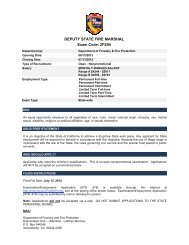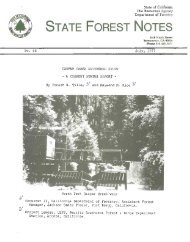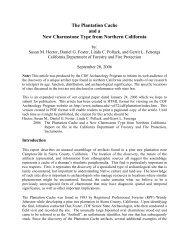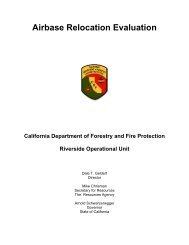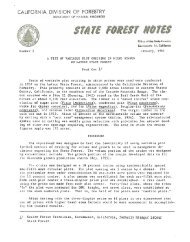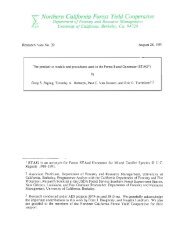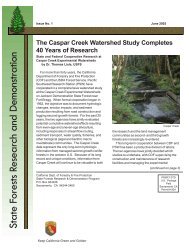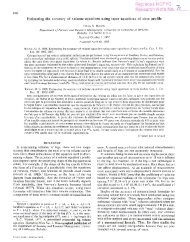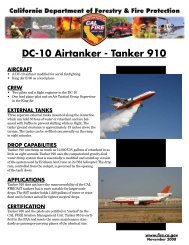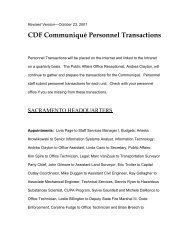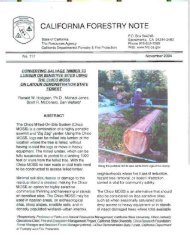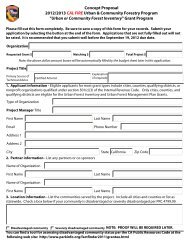USER'S GUIDE 2011 EDITION, Vol. 1 - Cal Fire - State of California
USER'S GUIDE 2011 EDITION, Vol. 1 - Cal Fire - State of California
USER'S GUIDE 2011 EDITION, Vol. 1 - Cal Fire - State of California
You also want an ePaper? Increase the reach of your titles
YUMPU automatically turns print PDFs into web optimized ePapers that Google loves.
ELIGIBLE LAND<br />
The intent <strong>of</strong> this law is to einsure that investments in timber stand improvement funded by CFIP<br />
will yield future marketable forest products and/or improved natural resources. Land must be<br />
zoned for uses compatible with forest resource management. Land in Agricultural Preserve<br />
(Williamson Act) or Timberland Production Zone (TPZ) qualifies. Properties with conservation<br />
easements or zoned for residential and/or commercial development may be eligible, if the<br />
easements or zoning place no restriction on forest management practices. If land is not zoned for<br />
timber production, the owner must maintain funded practices for at least ten years. A notice to this<br />
effect will be filed with the County Recorder. If the land is sold this provision is binding on the new<br />
owner or the CFIP grant must be paid back with interest.<br />
ELIGIBLE ACREAGE<br />
1. Timber-related practices must cover five acres or more.<br />
2. There is no minimum acreage limit for land conservation or habitat improvement projects<br />
QUALIFYING PROJECTS<br />
Projects proposed where timber has been harvested pursuant to the Z’berg-Nejedly Forest<br />
Practice Act <strong>of</strong> 1973 (Act) may qualify for CFIP financing if:<br />
1. All conditions imposed by the Act have already been satisfied (i.e., logging is complete and<br />
the area has been restocked and certified by a Report <strong>of</strong> Satisfactory Stocking).<br />
2. CFIP practices are not part <strong>of</strong> the minimal requirements <strong>of</strong> the Act and will not be used to<br />
meet those requirements.<br />
Resource management work that is required subsequent to harvesting under the Act is not<br />
eligible for CFIP funding.<br />
THE APPLICATION/CONTRACT PROCESS<br />
1. Contact your local CAL FIRE forester to determine if your property and project are eligible<br />
for funding. The CAL FIRE forester can advise you <strong>of</strong> the availability <strong>of</strong> funds in your area.<br />
Generally CFIP application requests exceed the funds available and applications are<br />
prioritized, using ranking criteria specified in the CFIP regulations. Replanting forestland<br />
that has burned generally are the first to be funded (when funds are available for this<br />
activity), but most eligible projects can eventually be funded given adequate lead-time.<br />
2. Fill out Application found on page 13 herein.<br />
3. Include a project description (see explanation and guide on Page 6 and 46.<br />
4. Include an accurate project map with a clear legend, legal description and north arrow.<br />
5. If your application is approved, CAL FIRE will provide a formal contract (called <strong>Cal</strong>ifornia<br />
Forest Improvement Program Agreement). By signing the contract, landowners agree to<br />
perform the project as proposed in return for CFIP financial assistance.<br />
NOTE: Work on any practice where reimbursement is expected under a CFIP agreement, including<br />
designing a management plan, cannot be started until a fully executed and signed copy <strong>of</strong> the<br />
agreement is received from CAL FIRE.<br />
CFIP User Guide Ver. 11-1-11 3




